Inertial
Mass
Back
to Physics World
Back to Special Relativity
The
concept of inertial mass is physics has been described in various ways. In
classical Newtonian mechanics Mach’s definition is often used. From herein if
the term mass is used unqualified then it referrers to the inertial mass
of the object. This definition
assumes Newton’s third law to
Newton’s
Third Law: For every action there
is an equal and opposite reaction.
For
example: If body 1 exerts a force of F21
on body 2 and body 2 exerts
a force F12
on body 1 then
![]()
Force is defined as the time rate of
momentum, p, where p is defined as the product of mass m
and velocity v. That is
![]()
![]()
The mass of any body is always taken as a
positive quantity. This is contrary to the popular belief that force is defined
as
![]()
However
if the mass is constant then m can be taken outside the derivative and
there yields the equality f = ma. If m1
is the mass of body 1 that has an acceleration of a1
and m2
is the mass of body 1 that has an acceleration of a2,
each body having a constant mass, then

Eq.
(5c) can be written in terms of the magnitudes of acceleration as
![]()
Eq.
(6) embodies what is known as Mach’s definition of mass. Thus,
in Newtonian mechanics, if two bodies are allowed to exert equal and opposite
forces on each other then the mass of any body can be given once a standard body
is defined. I.e. if we let m1
be the mass standard then m2
is determined. Another definition, one that is valid in both Newtonian and
special relativity, is based on The Principle of Conservation of Momentum.
In regards to this situation Herman Weyl wrote [1]
According
to Galileo the same inert mass is attributed to two bodies if neither
overruns the other when driven with equal velocities (they may be imagined to
stick together upon collision).
This
is known as Weyl’s definition of mass [2]. This is illustrated
in Figure 1 below. It follows that if u1+2
= 0 then m1
= m2,
if v1+2
< 0 then m1
< m2
and if v1+2
> 0 then m1
> m2.
See Figure 1
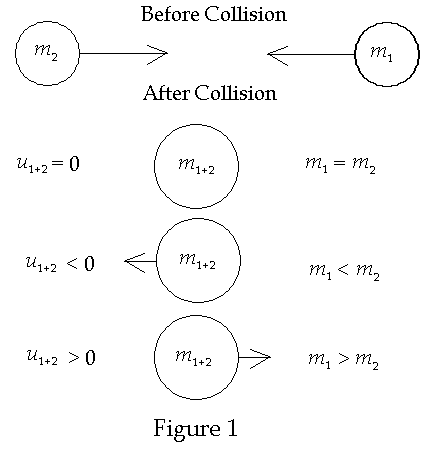
Consider
a system of particles that collide at the same event where n particles go into
the collision and p particles come out of the collision. I.e. particles 1 to n
are the n particles that go into the collision. Particles n +1 to n + p are the
p particles that come out of the collision.
This is illustrated in Figure 2 below where as an example we have set n =
5 and p = 4.
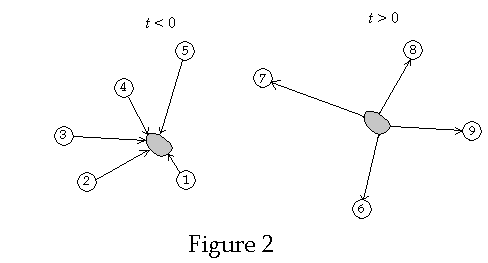
We
will use this diagram and examine in detail the principle of conservation of
momentum which states that there are quantities mk,
called the inertial mass of the kth particle, such that
that in any collision process, where there are n incoming particles with
velocities v1,…,
vn
and p outgoing particles with velocities v1+1,…,
vn+p
respectively, the equality

holds
in all inertial frames of reference. The quantity p = mkvk
is defined as the linear 3-momentum of the kth particle. Note: Mass
defined in this way is sometimes referred to as relativistic mass. After m
is determined in this way the quantity p = mv is well
defined. Thus once we known m we can define momentum. So basically what
Eq. (1) says is mass is defined such that momentum is conserved. A
derivation for the magnitude of m was devised by Tolman and is very
popular in relativity texts.
One of the earliest
concepts of a mass in relativity was written up in Einstein’s famous 1905
paper On the Electrodynamics of Moving Bodies” where he spoke of
longitudinal and transverse mass [4]. These were defined as the coefficient of
proportionality between the force as measured in the rest frame to acceleration
in the moving frame. This definition never caught on since now physicists only
write equations such that all quantities are expressed in the same frame. This
led to a different value for transverse mass than Einstein used. Einstein used
the electric force, i.e. the force on a charged particle, as an example. In the
year that followed Max Planck showed that Einstein’s relation could be written
in the form [5]
![]()
where
![]()
where
m0
= m(0) is the proper mass or rest mass
of the particle. Taking
relativity on a new course, Richard C. Tolman and Gilbert N. Lewis objected to
the fact that relativistic mechanics was so far based on electrodynamics in that
the expression for the velocity dependence on mass had been derived from
electrodynamics. Tolman and Lewis
were convinced that mass should [6]
… be obtained merely from the conservation laws and the principle of relativity, without any reference to electromagnetics
Mass
of a Tardyon
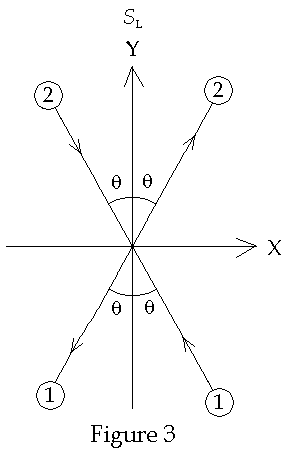
Now
consider the same collision from an inertial frame it S’ that has the
same x-component of velocity as particle 1. The velocity of particle 1 will have no component in the y-direction
but will initially have a speed in the +y’-direction of v0.
After the collision particle 1 will move in the –y’-direction with
speed of magnitude u0.
See Fig. 3 below
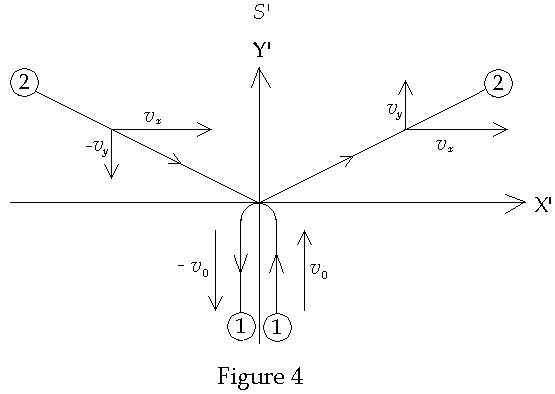
Prior
to the collision particle 2 will move in the –x’-direction with speed
of magnitude vx
and in the –y’-direction with speed of magnitude vy.
If we observe this same collision in the frame in which particle 2 has no x-component
of velocity then we have the situation described in Fig. 4 below.
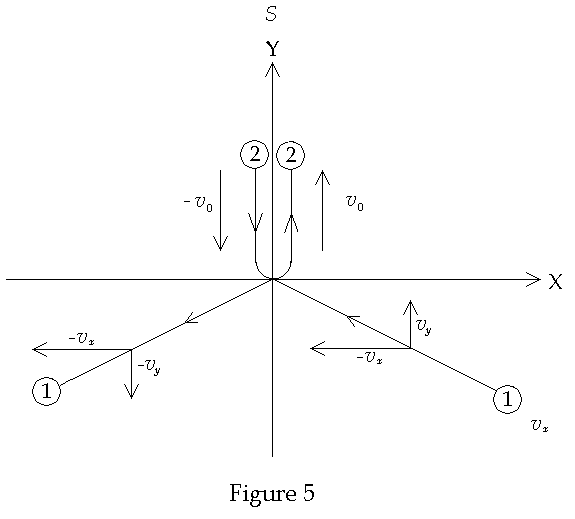
S’
moves relative to
S in the +x-direction with speed vx.
It can be shown that the relationship between the y and y’
components of velocity of the particles is given by
![]()
Thus
since ux
= 0, vy
= v0 and uy
= vy
we have
![]()
In S’
particle 1 moves with a speed V given by
![]()
It will
be assumed that the mass of a particle is at most a function of the particles
speed. As observed from S, conservation of the y-component of
momentum demands, upon applying Eq. (11), gives
![]()
Solving
for m(v) gives
![]()
Substituting
Eq. (15) into Eq. (18) gives
![]()
Define
the proper mass m0
of the particle as
![]()
Since
this relation must hold under all conditions it must also hold for small values
of v0.
Therefore
![]()
Mass
of a Luxon
The
procedure above assumes that v < c. We now ask - What is the mass of a
particle which travels at the speed of light? Such
particles are known as luxons. A photon is the most well known example of
a luxon. To find the mass of a luxon we first
express Eq. (17) as
![]()
where E
= gmc2
is the total
inertial energy (kinetic energy + rest energy) of the particle. For luxons E
= pc and therefore m0
= 0. Therefore we
have the important result - The proper mass of a photon is zero! This
also means that the proper mass of any luxon is zero. However the
(inertial/relativistic) mass of photons/luxons is still l related to its
momentum by m = p/v. Since v = c and
m = pc then
![]()
which is to be expected from E = mc2 . Notice that this relation does not define mass. It is a relationship between the particles mass and its energy. In that sense the relation is a consequence of the definition m = p/v and the energy-momentum relation E = pc. Since the energy of a photon is related to the photon’s frequency by E = hf then Eq. (2) can be expressed as
![]()
References:
[1] Philosophy
of Mathematics and Natural Science, Herman Weyl, Princeton
University Press, (1949), page 139.
[3] The Classical and Relativistic Concepts of Mass, Erik Eriksen and
Kjell Voyenli, Foundations of Physics, Vol. 6, No. 1,
(1976).
[5]
Das Prinzip der Relativitat und die Grundgleichungen der Mechanik, Max
Planck, Verhandlungen der Deutschen Physikalischen Gesellschaft, 4
131, 136-141 (1906).
[7]
Non-Newtonian Mechanics: The mass of a moving body, R.C. Tolman, Philosophical
Magazine, 23, (1912), pg. 375-380.
Back
to Special Relativity
Back to Physics World